Organization of surface drainage
In the courtyard of a private house, on the roads, near shops, parks and squares, it is necessary to get rid of a large accumulation of water after rain or melting snow. In marshland or clay, water not diverted from the summer cottage, during the first frosts, turns into ice, destroying plants and tearing the roots of young trees. To avoid such a catastrophe will help timely organization of surface runoff and drainage, which must be planned before the completion of construction.
About what can happen if you ignore the need for drainage and how to prevent it, it will be useful to read in the article below.
Consequences of the destructive power of water
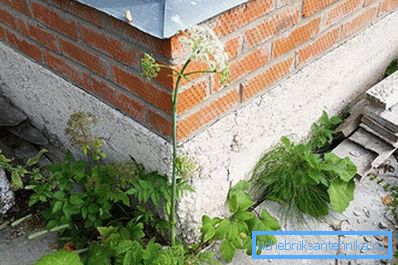
Surely, many people are familiar with the situation when after winter there was a crumbling of concrete foundations. This is one of the results of the absence of a drainage system. Here's what happened: the water absorbed during a rainy autumn crystallized in winter, turning into ice, and “ripped” the outer layer of concrete from the inside.
The detrimental effect of "uncontrolled" water can be seen in other examples. The asphalted surface of the yard may have small cracks that are invisible to the eye. The water, which has nowhere to go, will fill them and will surely show itself during the frosts. The owner of this yard is doomed to considerable expenses in the spring.
It is obvious that the presence of drainage will significantly save money on the restoration and repair in the future. You can get an idea of what the surface drainage is good for and what they generally are, about the principle of its construction and what you need to do by reading this article to the end.
Wastewater disposal methods
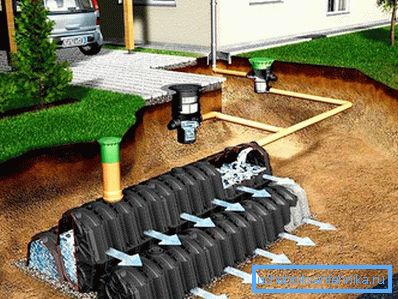
Before considering each method separately, it should be noted that an integral part of each of them is the drainage system.
The principle of surface drainage is to collect excess water from the surface and divert it into the drainage or special storm sewer. Collecting water from the surface of the roof, the drainage system is actually the “high point” of the overall drainage system. Its continuation can be performed in one of the following ways.
The entire surface drainage can be divided into three types:
- dotted;
- linear;
- combined.
Point drainage
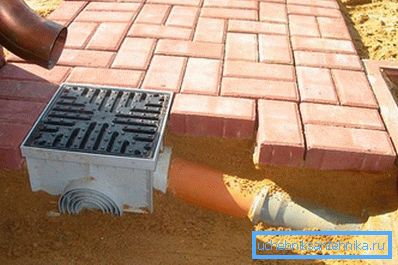
The name of this method of water diversion speaks for itself. Water is collected at certain points. This may be a plot in front of the house, in the basement. Water collection points may be small platforms near the building or gazebos. Without fail, such points are places under the drain pipes.
When organizing a point drainage system, water intakes and sewage pipes, as well as components necessary for them (corner, tee, etc.) will be needed.
Water intakes come in various configurations, and you need to select them according to their location. For example, if such a place is located on a circular platform, it makes sense to set up here a “trap” of the same shape. If this is the entrance to the house, it is more logical to put a rectangular water intake.
The pipe is selected based on the amount of water taken. It is better to use a thick-walled plastic pipe for external use. It is more resistant to frost and easier to mount.
Storm-water inlets are installed directly under the drainpipes on a layer of concrete of 10 cm and, tightly connected to the sewer pipe with the help of components, are securely fixed.
The pipe is placed in a prepared ditch shallow from the surface of the earth, so as not to lose the difference in levels with other water intakes, on a layer of sand, with a slope of 1 cm in the direction of discharge.
Other water intakes are installed at their water collection points and are connected by “branches” to the main pipeline, which is located below all receivers. Such connections can be made with the help of tees with transitions, but it is better to do this through wells, through which it will be easier to clean the pipeline from debris into it. They can also be used as sand traps if the bottom is made below incoming pipes.
The water intake grids should be a few millimeters below the finishing surface of the site. This can be traced through the cord and level.
Linear drainage
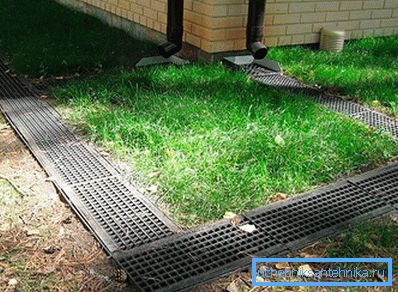
Line drainage is similar to the line, hence the name.
Such a drainage system, in contrast to a point drainage system, collects water over the entire area at once. Carrying out earthworks for its device is also not required. It is possible to assemble a linear drainage system when the main part of the yard already has a finished look.
For the assembly of this type of system, gutters are used, they are called trays. The trays have varying degrees of strength and are made of different materials. It can be concrete trays - reinforced and general purpose, plastic, polymer concrete, polymer sandstone, and also steel.
Depending on their location, trays of different strengths are selected. For example, if the tray should be located at the place of passage of the car, a more durable product is selected that will withstand heavy loads.
Tip! Depending on how much water the system will drain, the trays are selected in depth and width.
Trays are installed at the junction of two planes of the yard, having a slope of 5 mm per 1 m in his direction. The line of trays can be installed along the gate, then the courtyard is one common plane with a slight bias towards the gate.
Gutter and sand traps complete this system. It is going to be quite simple. As in the point system, the outlets are installed under the drainpipe and are connected to a tray, which will then drain the water.
The free space on all sides of the tray should be about 10 cm, in the future it will be filled with concrete. Trays are also installed on the concrete "cushion" near the finished surface of the yard under a slight bias. The upper part of the tray should be 5 mm below the surface of the lot.
Joints between trays are treated with sealant, eliminating the possibility of water leakage. At the end of the line it is necessary to install a trash box. The sand, like a heavy fraction, will sink to its bottom and will not enter the pipeline, which drains water into the storm sewer or other discharge point. All trash in the sand trap can be easily removed by removing the protective grid. On all trays are also installed lattice, delaying the foliage.
Tip! The grilles also protect people from accidental injuries and trays from cars. Having a decorative look, lattices do not spoil a site.
Combined drainage
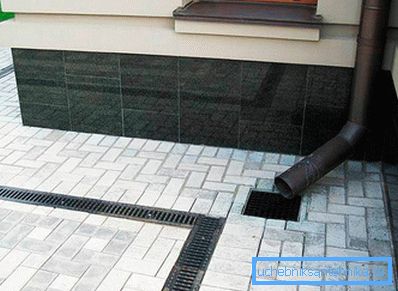
Combined surface drainage is the addition of one system to another. Having collected water from the roof, a point drainage system, “grabbing” a couple of points along the way, can easily connect to a linear system, the task of which is to collect surface runoff from the yard. Together, these two systems become one, combined.
It may be the other way around, if the part of the territory served by the linear system is above the site controlled by the “point”.
Each branch of such a system is assembled by its own rules, but the general sense is preserved: the surface drainage system saves the house and yard from destruction, dampness and frequent repairs.
Video
This video is a guide to installing surface drainage systems: